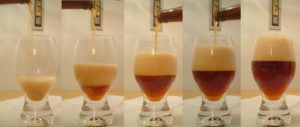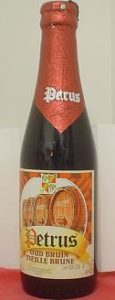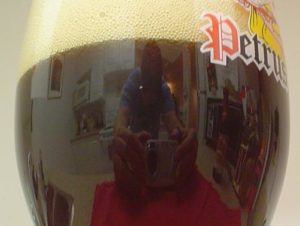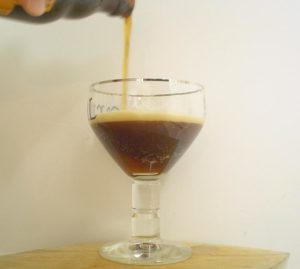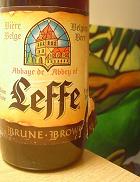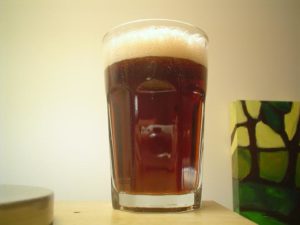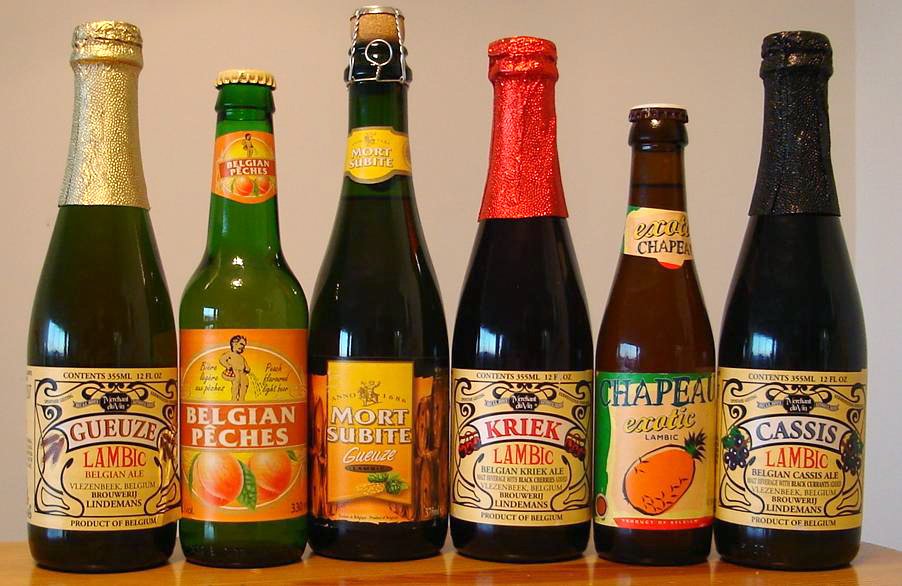
There are a few times my good wife is very pleased with this hobby. One is when there is Guinness in the house and one is when there are lambics. These historic vestiges of a Belgian need to capture summer fruit are made without added yeast…because the valley of the Senne is loaded with airborn natural yeasts. In the winter when these beers can be made, the windows at fairly musty unsanitary breweries are opened to expose open wort vats of straight gueuze (or geuze) or fruited lambics in traditional flavours like cherry kreik or black current cassis and the beers undergo spontaneous fermentation after which they are casked. This handy web page will likely tell you more than you need to know about the process.
One difficult thing about them, particularly the fruit beers like the raspberry – or framboise – by Mort Subite that I reviewed last March is that they really can come across as only an incredibly concentrated take on the fruit. One friend recently exclaimed when trying her first cassis: “the children would drink this for God’s sake!” Well, it is sort of the fruit juice the Lord made. The other difficult thing is buying something that calls itself lambic, is a wee bit cheaper only to find out that it is a syrup based brew and not the real deal with fruit gurgling in the ale through fermentation. I try to stay away from those. But let’s see how these work out:
 Lindemans Kriek: This pours a bright red with brown tones with a whipped mousse head of pink. There is lots of cherry flavour but also a rustic hoppiness cutting through. It is a sweet cherry flavour but, as it to be expected from the style, a vineous sour tang to the beer.Lindemans lambics always seem to have more to them for me than others, something twiggy or a veracity to the fruit like you get when it is your hand that does the picking. This is especially the case when you drink them at room temperature. This 375 ml bottle from Vlezenbeek, Belgium probably cost 5.99$ USD so it is pricy but when you think about the real costs that go into production, it is not unreasonable. BAers rave.
Lindemans Kriek: This pours a bright red with brown tones with a whipped mousse head of pink. There is lots of cherry flavour but also a rustic hoppiness cutting through. It is a sweet cherry flavour but, as it to be expected from the style, a vineous sour tang to the beer.Lindemans lambics always seem to have more to them for me than others, something twiggy or a veracity to the fruit like you get when it is your hand that does the picking. This is especially the case when you drink them at room temperature. This 375 ml bottle from Vlezenbeek, Belgium probably cost 5.99$ USD so it is pricy but when you think about the real costs that go into production, it is not unreasonable. BAers rave.
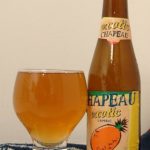 Chapeau Exotic: Pineapple beer. Not this
Chapeau Exotic: Pineapple beer. Not this
sort of pineapple beer but still pineapple beer. By Brouwerij De Troch in Wambeek, Belgium. As still a beer as ever I have had. It smells like a jube-jube of a slightly overripe pineapple husk. There is fairly true pineapple flavour…truer than the aroma…but do you want that in a beer? Sharp acidic effect in the mouth like the real fruit. You know…I don’t think this is a syrup based lambic. I think some Belgians actually import pineapple to make this. What a weird world it is. 1.5% alcohol, too. Really weird. Advocates are rightly unkind. Thankfully only a 250 ml bottle. Hey…they make banana beer!Update: Having noted that the label on my bottle is not the label I see elsewhere on the web and noting the 1.5% alcohol content which would not sustain shelf life…I am wondering if the LCBO has been fobbed old stock? Look at the advocates comments. The ones who rate high say the head was huge or at least it was highly carbonated. Those that do not found it flat. Hmmmm….
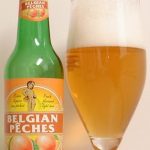 Belgian Pêches: By the Lefebvre brewery at Quenast, Belgium.
Belgian Pêches: By the Lefebvre brewery at Quenast, Belgium. At 3.5%, a whopping 133% stronger than the last one. A lightly pinked straw brew with a little cloud to it sits under white foam. The smell is pure ripe fruit. As with both of the previous beers, there is a orchard reality to the fruit, the flavour is textured and maybe a bit over ripe compared to grocery store stickered facsimile. The one advocate calls this syruped but, for me…ok…I dunno. The body is light otherwise and no real hoppy flavour. Hey – there is actually an ingredients list: water, malt, wheat, hops, yeast, peach juice (20%), sugar, flavour…FLAVOUR!?!? What the heck is that supposed to be? Ok – it’s got to be a phoney. Yet I have been offended by other lambic phoneys more.
At 3.5%, a whopping 133% stronger than the last one. A lightly pinked straw brew with a little cloud to it sits under white foam. The smell is pure ripe fruit. As with both of the previous beers, there is a orchard reality to the fruit, the flavour is textured and maybe a bit over ripe compared to grocery store stickered facsimile. The one advocate calls this syruped but, for me…ok…I dunno. The body is light otherwise and no real hoppy flavour. Hey – there is actually an ingredients list: water, malt, wheat, hops, yeast, peach juice (20%), sugar, flavour…FLAVOUR!?!? What the heck is that supposed to be? Ok – it’s got to be a phoney. Yet I have been offended by other lambic phoneys more.
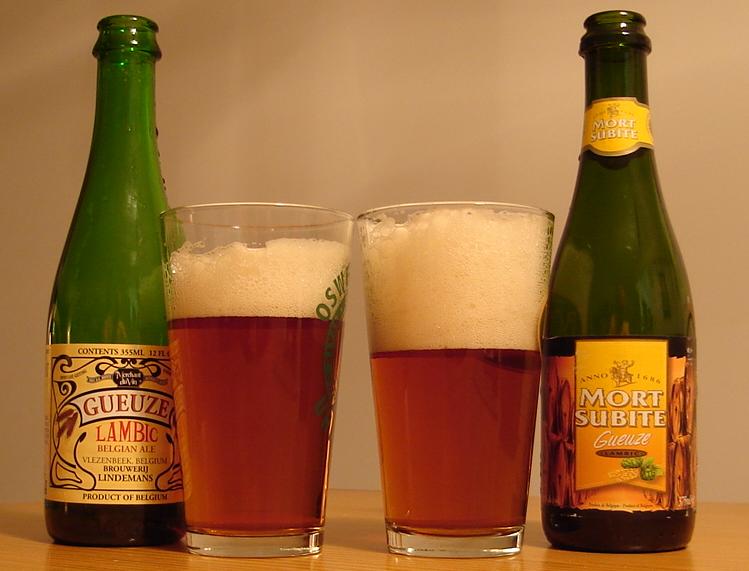
Lindemans Gueuze: From Vlezenbeek, Belgium.  I yapped about gueuze earlier this summer but only found this example a few weeks ago in Ithaca at the Finger Lakes Beverage Center. A fine white foamy rim over deep straw brew. This is a drier version of the style than the other two, juicy and maybe a bit cider-ish. More pear juice than apple in the fruit – maybe passion fruity, too, but have I had a real passion fruit? Have you? I’ve had a kid’s juicebox with the words “passion fruit” on it…and is it passion fruit or passionfruit? But not like added flavour. It is all coaxed out of the pale malt. Brightly acidic as well. Just 4% so the kind of beer your mother may like…ok, the kind of beer my mother likes. Plucky Belgians. But BAers seem to want more. More acid. More barnyard funk from the wild yeasts. Is there anything the advocates won’t demand?
I yapped about gueuze earlier this summer but only found this example a few weeks ago in Ithaca at the Finger Lakes Beverage Center. A fine white foamy rim over deep straw brew. This is a drier version of the style than the other two, juicy and maybe a bit cider-ish. More pear juice than apple in the fruit – maybe passion fruity, too, but have I had a real passion fruit? Have you? I’ve had a kid’s juicebox with the words “passion fruit” on it…and is it passion fruit or passionfruit? But not like added flavour. It is all coaxed out of the pale malt. Brightly acidic as well. Just 4% so the kind of beer your mother may like…ok, the kind of beer my mother likes. Plucky Belgians. But BAers seem to want more. More acid. More barnyard funk from the wild yeasts. Is there anything the advocates won’t demand?
Mort Subite Gueuze: By Brouwerij De Keersmaeker in Kobbegem, Belgium. This is one of the ones I  yapped about last time. By the way, I have instituted a policy hereabout of benchmarking which is a fancy way of saying I get to repeat myself to figure out if any of this makes any sense. If you are going to be paranoid, I say you better do the checking up on yourself by yourself. It is sweeter and a bit richer or rounder in body than the Lindemans with a bit sour under it all. Less like cider, less brightly acidic, more barnyard perhaps. Still only 4.5% but that is three times that somewhat insanely odd pineapple thing above. The head was a nice off white and quite a rocky mousse of it all, the beer ever so slightly lighter in colour. There must be some quite beefy gueuzes out there as, again, many advocates find this comes up short.
yapped about last time. By the way, I have instituted a policy hereabout of benchmarking which is a fancy way of saying I get to repeat myself to figure out if any of this makes any sense. If you are going to be paranoid, I say you better do the checking up on yourself by yourself. It is sweeter and a bit richer or rounder in body than the Lindemans with a bit sour under it all. Less like cider, less brightly acidic, more barnyard perhaps. Still only 4.5% but that is three times that somewhat insanely odd pineapple thing above. The head was a nice off white and quite a rocky mousse of it all, the beer ever so slightly lighter in colour. There must be some quite beefy gueuzes out there as, again, many advocates find this comes up short.
 Lindemans Cassis: This is the best of the bunch. Very fruit forward true black current flavour.
Lindemans Cassis: This is the best of the bunch. Very fruit forward true black current flavour.  Not sweetened like black current juice but full of the twiggy real berry flavour. I used to have 20 old bushes behind a barn I owned and this is the essence of a clear summer evening’s picking at the height of the season. There is a huge pink/purple lace-leaving mousse head over purple ale. Really lovely. Underneath, creamy yeast and French bready wheat framing the black current. Aged green hops accentualte the fruit. The finish is astringent. Wonderful.
Not sweetened like black current juice but full of the twiggy real berry flavour. I used to have 20 old bushes behind a barn I owned and this is the essence of a clear summer evening’s picking at the height of the season. There is a huge pink/purple lace-leaving mousse head over purple ale. Really lovely. Underneath, creamy yeast and French bready wheat framing the black current. Aged green hops accentualte the fruit. The finish is astringent. Wonderful.
A good introduction to the style. I am going to make a point of learning more and more.
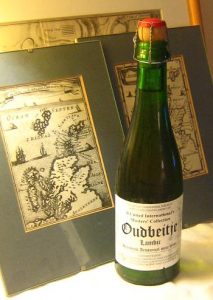 Oddly, a 750 ml label on a 375 ml bottle. The brewer tells us that this is a strawberry lambic, with the fruit sitting in the beer from one summer to the next spring. The importer gives a proportion of 1 kg of strawberries to every 4 litres. BAers warn that this is extremely sour but upon opening there is a waft of sweet strawberry jam. It’s on the cork. The glass has a hint of it in amongst strong musty barnyardy smells. Within a minutes, the jammy scent is gone.
Oddly, a 750 ml label on a 375 ml bottle. The brewer tells us that this is a strawberry lambic, with the fruit sitting in the beer from one summer to the next spring. The importer gives a proportion of 1 kg of strawberries to every 4 litres. BAers warn that this is extremely sour but upon opening there is a waft of sweet strawberry jam. It’s on the cork. The glass has a hint of it in amongst strong musty barnyardy smells. Within a minutes, the jammy scent is gone.
 Gold amber ale under large frothier lazy rim and foam that quickly fades then leaves town. The smell is beyond brett. The unripe Annapolis Valley Gravenstein green apple of my Nova Scotian youth gone mad with aspirations of manure pile. Quite plainly watery at the outset then acid and more acid…then one note of poo. Not refreshing to slightly sub-Cromwellian stridency. Annoying. Then at the end a hint of apple cider. Foul. I wonder if this is an example of mass reputation piercing the veil of reality – mob craftism.
Gold amber ale under large frothier lazy rim and foam that quickly fades then leaves town. The smell is beyond brett. The unripe Annapolis Valley Gravenstein green apple of my Nova Scotian youth gone mad with aspirations of manure pile. Quite plainly watery at the outset then acid and more acid…then one note of poo. Not refreshing to slightly sub-Cromwellian stridency. Annoying. Then at the end a hint of apple cider. Foul. I wonder if this is an example of mass reputation piercing the veil of reality – mob craftism.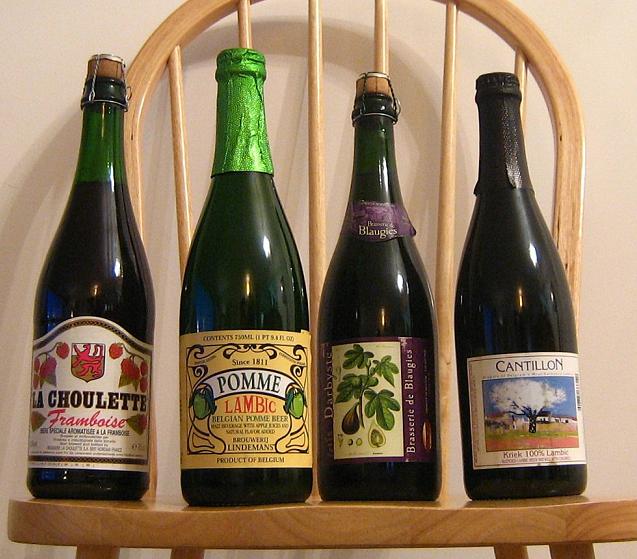
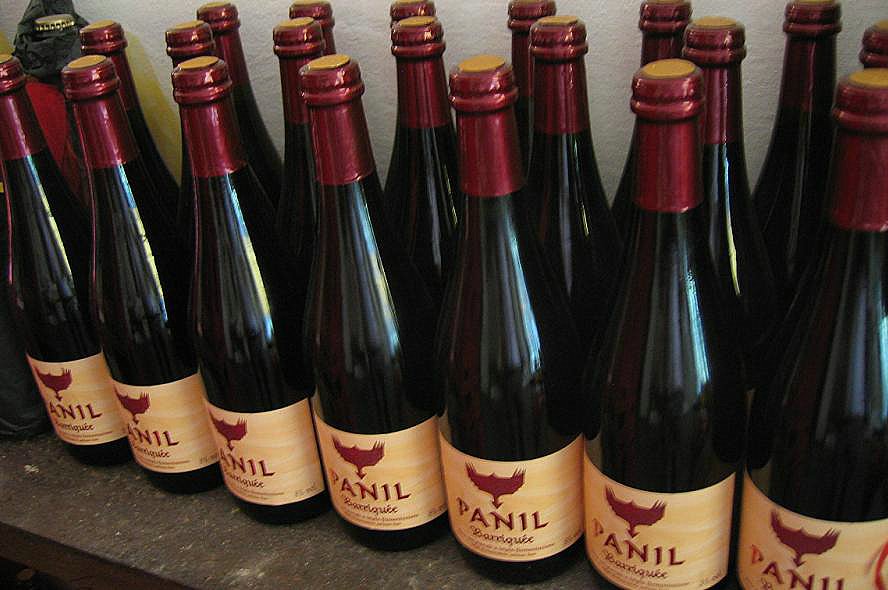


 Lindemans Kriek: This pours a bright red with brown tones with a whipped mousse head of pink. There is lots of cherry flavour but also a rustic hoppiness cutting through. It is a sweet cherry flavour but, as it to be expected from the style, a vineous sour tang to the beer.
Lindemans Kriek: This pours a bright red with brown tones with a whipped mousse head of pink. There is lots of cherry flavour but also a rustic hoppiness cutting through. It is a sweet cherry flavour but, as it to be expected from the style, a vineous sour tang to the beer. Chapeau Exotic: Pineapple beer. Not
Chapeau Exotic: Pineapple beer. Not 







